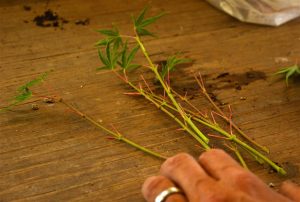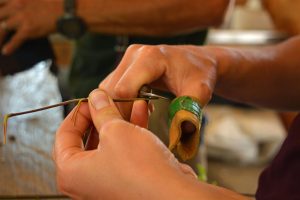 In our last blog post, we talked about Japanese maple propagation in general and why we graft, and today we will lay out the steps that we use in our grafting program. With a few basic tools, a little bit of plant material, and a good bit of patience, you can build a Japanese maple collection with your own two hands.
In our last blog post, we talked about Japanese maple propagation in general and why we graft, and today we will lay out the steps that we use in our grafting program. With a few basic tools, a little bit of plant material, and a good bit of patience, you can build a Japanese maple collection with your own two hands.
Any plant propagation, grafting included, begins months before you actually make any cuts. This means you need to think about keeping your stock plants hydrated, properly fertilized, and free of pests the entire season leading up to grafting day. In our area of Northwest Washington, grafting day usually comes in late July and goes into August. It depends on the variety and the growing conditions, but you are waiting for the new wood on the mother plant to harden off; the wood should feel firm as opposed to tender and whippy. Next we’ll line out the steps…
First grab your materials:
• Acer palmatum rootstock (you did buy a rootstock right?), roughly pencil thickness
• Grafting knife (absolutely razor sharp, nothing less will do)
• Budding strips (or some other tying material)
• Grafting wax
• Plastic bag and labeling material
Next harvest your budwood:
• Collect budwood in cool morning hours, and keep it shaded during collection
• Choose straight shoots from this year’s wood…ideally the diameter of the budwood is ½ to 1/3 the diameter of the rootstock. Good budsticks are usually between 6” and 12”.
• Snip off all leaves but leave a small stub of petiole (the leaf stem)
• Store budwood immediately in a plastic bag with a light spritz of water. If not grafting immediately, store the bag in the refrigerator for up to a day.
• Sanitize all cuttings tools
• We use a side veneer graft . Make the cut in the rootstock first and then cut your scion to match in both width and length. The goal is to align both cambium layers perfectly on the sides and the tip.
• Be safe and protect your fingers! This can be a dangerous cut since the blade is moving toward your body.
• Place the scion piece into the rootstock cut and then wrap tightly with a budding strip. The goal here is to cover all cut surfaces to prevent desiccation and to provide clamping pressure and achieve good contact between the two mating surfaces.
• Place a dab of grafting wax at the top of the cut to prevent moisture from pooling at the top of the graft.
• We put our new grafts into a misted area (1 second every 10 minutes) of a shaded greenhouse for two weeks. Some people place a baggie over the entire plant. The idea is to keep the plant and the new graft area in a high humidity environment during the early healing phase.
• After two weeks, we remove them from the mist but they remain in the greenhouse until the following spring.
If the graft fails at any point, it is usually obvious. The scion wood will turn brown or black and look withered. If the graft takes, it will remain bright, and buds will look plump and colorful. If you are successful and the scion pushes growth the following spring, head back the rootstock to a few inches above the graft union and watch your new tree grow.



Can you use these multi-purpose grafting tools on japanese maples?
We have never tried using grafting tools on maples. We do the maple grafting in the summer when grafting tools would not work, but there are nurseries who graft maples during the dormant season, and that is when you might try it. The ‘keyhole’ graft the tools make work best on dormant wood. We do use a grafting tool for dormant grafting of grapevines and occasionally fruit trees.
When is the ideal time of year to cut the branch to make scion and when is it ideal to graft?
We do most of our grafting mid-summer. Our stock plants’ new growth has set their terminals and is hardening off. Other nurseries will do early spring grafting, cutting dormant scion wood, storing it in a cooler, and then grafting as rootstocks start growing. For us, labor balance favors the summer grafting as winter is usually too busy in the nursery. (We do our conifer grafting then.)
I’m looking to purchase bareroot JM liners, are you able to ship them?
We do not ship Japanese maples.